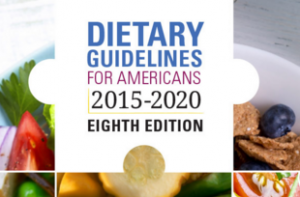The 2015 Dietary Guidelines, at long last
The 2015 Dietary Guidelines are out.

They are now online in a version that takes up dozens of screens with annoying drop-down boxes. It’s hard to navigate, and if it’s searchable, I can’t figure out how (OK, it’s searchable but doesn’t work all that well).
First the good news. These Dietary Guidelines—for the first time—attempt to focus on foods and dietary patterns:
Previous editions of the Dietary Guidelines focused primarily on individual dietary components such as food groups and nutrients. However, people do not eat food groups and nutrients in isolation but rather in combination, and the totality of the diet forms an overall eating pattern.
They almost succeed in this mission. The Guidelines say:
- Follow a healthy eating pattern across the lifespan [Pattern].
- Focus on variety, nutrient density, and amount [Pattern].
- Limit calories from added sugars and saturated fats and reduce sodium intake [Oops: Nutrients].
- Shift to healthier food and beverage choices [Pattern].
- Support healthy eating patterns for all [Pattern].
A healthy eating pattern, they say:
- Includes foods from various groups [Pattern].
- Limits saturated fats, trans fats, added sugars, and sodium [Oops: Nutrients].
As for (Oops) Nutrients:
- Less than 10% of calories from added sugars [this is new, but consistent with many other reports such as the one from WHO]
- Less than 10% of calories from saturated fats [in the Guidelines since 1990]
- Less than 2,300 mg sodium [no change from 2010]
Why Oops? Because these Dietary Guidelines, like all previous versions, recommend foods when they suggest “eat more.” But they switch to nutrients whenever they suggest “eat less.”
In the 2015 Dietary Guidelines,
- Saturated fat is a euphemism for meat.
- Added sugars is a euphemism for sodas and other sugar-sweetened beverages.
- Sodium is a euphemism for processed foods and junk foods.
If the Guidelines really focused on dietary patterns, they wouldn’t pussyfoot. They would come right out and say:
- Eat less meat [OK, they do but only under the euphemism of “protein” and only for males. “Some individuals, especially teen boys and adult men, also need to reduce overall intake of protein foods (see Figure 2-3) by decreasing intakes of meats, poultry, and eggs and increasing amounts of vegetables or other underconsumed food groups.” But what about processed meats? Not a word that I can find.
- Cut down on sugary drinks [OK, it says “drink water instead of sugary drinks,” but good luck finding that statement without knowing where it is].
- Eat less processed and junk food.
Why don’t they? Politics, of course.
Recall that Congress weighed in with an Appropriations Bill that called for an investigation of the scientific basis of the Guidelines and granted $1 million to the National Academy of Medicine to take them over.
Recall also that the secretaries of USDA and HHS said that the Guidelines would not say anything about sustainability as a rationale for advising eating less meat.
So let’s count the 2015 Guidelines as a win for the meat, sugary drink, processed, and junk food industries.
Other concerns, nutritional and otherwise:
- Calories: The Guidelines deemphasize calories. They dropped the information about food sources of calories from the 2010 edition, even though calorie balance remains a—if not the—major public health nutrition problem (an Appendix gives calorie needs).
- Portion sizes: the best way to control calorie intake is by eating smaller or moderate portions. If the Guidelines talk about portion size, it must be well hidden.
- Cholesterol: the recommendation to limit cholesterol has been dropped, but the document says, confusingly, that “this change does not suggest that dietary cholesterol is no longer important to consider when building healthy eating patterns. As recommended by the IOM, individuals should eat as little dietary cholesterol as possible while consuming a healthy eating pattern.” Could the dropping of the limit have anything to do with egg-industry funding of research on eggs, the largest source of dietary cholesterol, and blood cholesterol? The Physicians Committee for Responsible Medicine has just filed a lawsuit on that very point.
- Protein: My pet peeve. The Guidelines use this as yet another euphemism for meat. “Protein” lumps meat together with seafood, poultry, eggs, nuts, seeds, and soy. But grains and dairy also have protein, so using this term makes no nutritional sense and obfuscates the message to eat less meat.
- Seafood: the document recommends 8 ounces a week of seafood high in omega-3s but low in methylmercury. That pretty much means salmon and sardines (anchovies are too salty).
I might have more to say when I can look at a document that is easier to read.
Full disclosure: I was a peer reviewer on an earlier version of this document.
Documents and commentary
- The HHS press release and the government’s digital press kit
- The Dietary Guidelines Advisory Committee Report
- USDA’s MyWins food guide
- Dietary Guidelines version of MyWins
- My Rogue Dietary Guidelines (with Tamar Haspel)
- CSPI’s press release and materials
- CSPI’s summary of the Guidelines’ major points
- The New York Times take (I’m quoted)
- Politico’s take (I’m quoted)
- Friends of the Earth (with a good summary of public input)
- Julia Belluz in Vox (comparison to Swedish guidelines)
- The official HHS version in JAMA Cardiology
- The Sugar Association’s predictable complaints
- The American Cancer Society’s complaints (no clear guidance on red and processed meats)
- The Distilled Spirits Council’s statement
- Time Magazine’s collection of reactions (including mine)
- The Washington Post on the confusion (I’m quoted)
- Food-Navigator’s take: a marketing opportunity
- The American Beverage Association’s reaction

